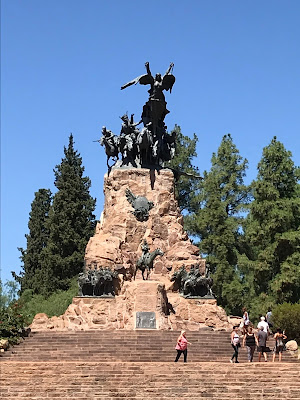Something happened between getting off the metro station and the hotel. Our tour leader, Christian, lost his money pouch, which contains a sizable amount of cash. Someone must have dipped into his pocket and took the pouch without him being aware of it. It was a very busy street, with many pedestrians on the sidewalk. It's a warning to all of us to be careful with our valuables. There and then I decided that I was going to wear my money belt in Santiago.
We did a quick orientation tour that evening, then went to the Mulato restaurant for a very nice Chilean dinner.
The next morning some of us went to drop off our laundry at a nearby laundromat. It costs 6,000 Chilean pesos, about US$10, and would be ready that evening. I plan to do my laundry once a week. So far it has worked out very well. It is much cheaper to have a laundromat do it than to have the hotel to do your laundry. When they come back, the laundry is always nicely folded.
We met at the Plaza de Armas to get ready for a
"Free" Walking Tour. The tour is free because they don't charge you an advance or fix fee. You pay based on what you think the tour is worth and what you want to give. The tour started at about 10:30am and lasted about 3-4 hours. In between, we stopped at a restaurant for a 45-minute lunch. It was a wonderful way to know the city and the history of Chile. Our guide Franco injected a lot of humor into his self-deprecating commentary on Chilean politics.
 |
| Ceviche at the Mercado Central |
 |
| These vendors sell this Chilean national drink |
 |
| A statue of Mary on top of San Cristobal Hill |
 |
| Chile grows a lot of fruits, some exported to the US |
 |
| Many of these crosses are all over St. Cristobal Hill |
 |
| Catedral Metropolitan at Plaza de Armas |
 |
| This restaurant's business boomed after President Clinton's visit |
 |
| The Presidential Palace where the Salvador Allende was overthrown |
 |
| Our tour guide Franco |
 |
| We took the funicular up to San Cristobal's Hill |
 |
| A small chapel on top of San Cristobal's Hill |
 |
| Chess playing citizens at Plaza de Armas |
 |
| Pre-Columbian artifacts at the Pre-Columbian Museum |
 |
| Chile is a big wine producer. Good wine sells for less than $10 |
 |
| Lots of seafood at the Mercado Central |
After the tour we took the funicular up to to San Cristobal Hill. It has a nice view of the city. On top of the hill is a statue of Mary and below the statue is a small chapel. Half way up the bill is a zoo. We also took a cable car to another part of the hill.
I also visited two museums in Santiago: the Pre-Columbian Museum and the Museo Historico Nacional. The former is a beautiful, well-done museum with explanation of what Chilean was like before the Spanish settlers came. It's worth the US$10 dollar entrance fee. The Museo Historico Nacional is an okay museum. It gives a lot of information about Chile's history, after the Spanish came, but only in Spanish. It looks old, but the entry is free.
The Central Market or Mercado Centro is an interesting place to visit. It has many vendors selling mostly seafood and many seafood restaurants. Outside the market there are a lot of vendors selling just about anything - fruits, phone accessories, clothes, knick-knacks, etc. The street market goes all the way back to the Plaza de Armas, the main square in Santiago.
All day long, there are many activities in the Plaza de Armas, ranging from entertainers, food vendors, people watchers, people using free wifi, and probably a few pick-pockets as well. Here you will also find the Tourist Information Center, where you can get maps or other information about Santiago and book tours as well.


























































